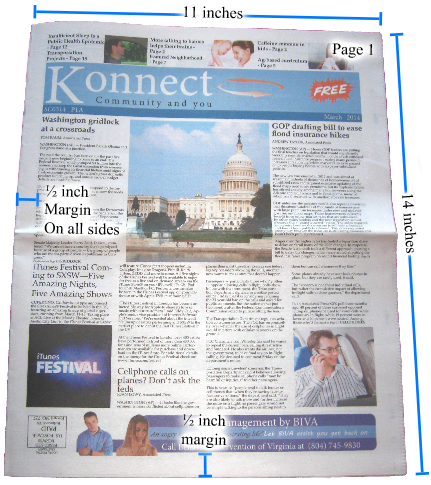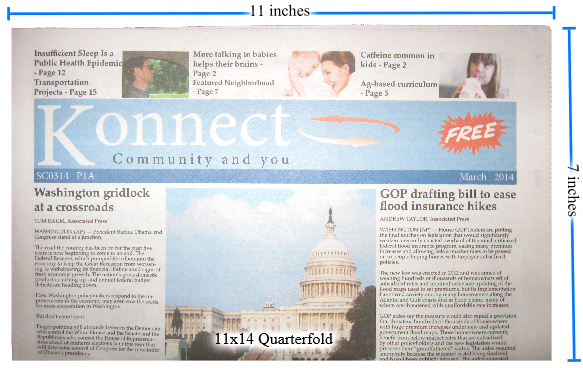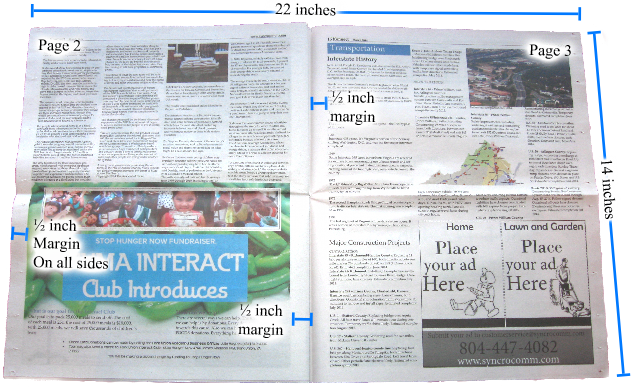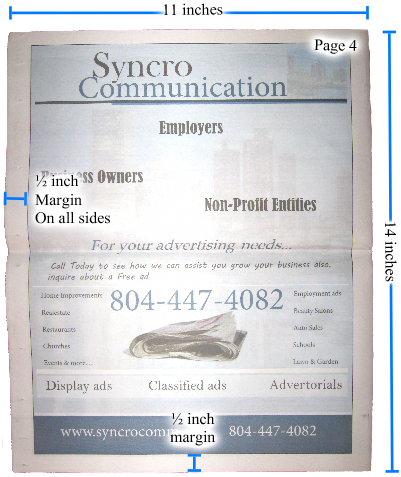Design and Layout
Newspaper Specifications and Requirements
Quick Specs
The following Specifications are the most important that we require and represent the most common problems submitted to us. These specifications don't apply to our Cloud Newspaper Designer which already incorporates these specifications.
- Half Inch Margin. All newspapers must have a half inch (.5 inch), white margin around all four edges of each page (top, right, left, and bottom). No bleeds.
- A Single, Print Ready PDF. We need a single, print ready PDF. All the pages need to be in one file.
- Individual, Consecutive Pages. We need the pages in the PDF to be in consecutive order, one page at a time (1, 2, 3, 4,etc.). We do not accept spreads.
- Multiple of 4 Pages. Page count must be a multiple of 4 (4, 8, 12, 16, etc.).
- CMYK Colors. Convert your PDF into CMYK colors.
- 100% Black Fonts. Convert all black text into 100%, true black (K). Black text that is a combination of CMY does not print well.
- 300 DPI Images. For best results, ensure that all your images are 300 DPI.
Acceptable / Unacceptable Software
You can use any desktop publishing software that will produce a print ready PDF in CMYK colors. Below is a list of common programs and if they are or are not acceptable to produce a print ready PDF:
Acceptable Design Software
- MakeMyNewspaper's Free Cloud Newspaper Designer — Our Designer eliminates most of the need to follow these specifications as it automatically takes care of these issues for you. In addition, our Designer has hundreds of stylish templates that takes care of most of the design work for you. There is nothing to download and can be accessed from any computer with an internet connection.
- Adobe InDesign — This is perfectly acceptable as it is a desktop publishing software designed for this type of project.
- Microsoft Publisher — This is perfectly acceptable. Although a bit more difficult to navigate, it can be used for your newspaper designs. Converting to CMYK in Publisher is tricky…especially trying to get 100% black fonts. You may use Publisher for your newspaper designs.
- Serif PagePlus — This is perfectly acceptable. This is the only Serif program that is a true desktop publishing software.
- QuarkXPress — This is perfectly acceptable.
- Mac/Apple Pages — Pages is a basic design program for home use. It can do the job, but be sure to follow all the specifications to convert to CMYK.
Unacceptable Design Software
- Adobe Illustrator — This is not acceptable. Illustrator is a vector editing program, not a desktop publishing software. Please do not use Illustrator for your newspaper designs.
- Adobe Photoshop — This is not acceptable. Photoshop is a photo editing program, not a desktop publishing program. It creates huge picture files that often do not have the correct font or CMYK information embedded in the PDF. Please do not use Photoshop for your newspaper design.
- CorelDraw — This is not acceptable. CorelDraw is a vector editing software similar to Adobe Illustrator. It is not a desktop publishing software and does not produce acceptable print ready PDFs for commercial printing.
- Microsoft Word — Word is not acceptable for PDF submission as it is not a desktop publishing software. It is a word processor and does not have the functionality to correctly convert a PDF to the correct CMYK settings or embed the necessary font information in the PDF. We will not accept PDFs created by Word.
- Microsoft PowerPoint — Powerpoint is not a desktop publishing software and lacks the capability to convert RGB to CMYK or embed the fonts needed for commercial printing. Please do not use PowerPoint.
* The open source Scribus and Broderbund's Printshop and Printmaster are designers that we are currently unfamiliar with as to their ability to create a commercial print ready PDF that is converted to CMYK colors and has the appropriate embedded fonts.
Layout Specifications (Uploaded PDFs Only)


Each page of an uploaded PDF must have a half (½) inch margin on all four sides (bottom, top, left, right). For instance, a 11" x 14" newspaper layout will have a final printable image of 10" by 13." The page size will still be 11" x 14" when you include the half inch margins. An 11" x 17" newspaper layout would have a printable area of 10" x 16". Broadsheet newspapers are 11" x 22". Your printable area is 10" by 21" for broadsheets.
Some Desktop Publishing software, such as InDesign, often adds crop marks when the PDF is actually created. Remove all crop marks from your PDF. To check your PDF dimensions, open your PDF and right click anywhere on the document. Select "Document Properties" and find the "Page Size." This number needs to be exactly 11x14, 11x17 , or 11x22 (in inches). See illustrations.
Backgrounds from Publisher and InDesign will place the background in the margins. We need a white .5 inch margin around all edges. You may need to adjust your background to compensate so that your background does not overlay the margin area.
Folding Specifications
All newspapers are half folded, then quarter folded, unless quarter folding is specifically requested not to be done. (all Classic newspapers newsprint sizes include an extra .3 inch on the right margin as standard with regards to web-press machines). The top half of your first page will be the visible front of your newspaper. See Quarterfold Illustration.
File and Page Specifications
If using our free Cloud Newspaper Designer, you do not need the following information.
Any file in Black and White must be sent in a PDF Format with a minimum resolution of 150 DPI. We do recommend having your file saved at 300 DPI.
Any COLOR file must be sent as PDF Format and only with CMYK coloring (not RGB). We recommend 300 DPI. Also, be sure to create your fonts as 100% black (K). It is essential to use a program that will embed all the fonts you use into the PDF. Some programs, such as Microsoft Word, were never meant for commercial printers and will not correctly embed the fonts. Because of the issues we have had with Microsoft Word, we will not accept any PDF created by that program. We strongly recommend using our free Cloud Newspaper Designer if you do not have any other Desktop Publishing Program.
All PDFs must be on one file. All PDFs will be printed in the page order of the file received.
If you need help creating a Print Ready PDF, we suggest using one of these Free PDF creators.
Coloring Specifications for Text
For optimal color printing we suggest 100% black fonts, gray-scale and CMYK, not RGB coloring. While RGB coloring will print in most cases fairly well when transferred to a black and white PDF, and a great many newspaper are printed this way, it is not quite as clear as the way suggested above. The reason for this is that converting RGB text to CMYK means that the colors are transposed somewhat, making the colors slightly different than RGB. For black text, use 100% black (K) text fonts in all color documents. RGB black converts to 4 color CMYK text. You will need to make sure the CMY are set to 0% and the K to 100% for black text. If you are using our Cloud Newspaper Designer and not your own publishing program, you need not worry about these issues.
A tutorial for Microsoft Publisher 2007 on how to convert to CMYK, including black text, can be found on our Design Tips Page. The tutorial will help anyone who is using a different program other than our free online Cloud Newspaper Designer.
Images and Print Quality
We are not responsible for the quality of the pictures you use. Although many pictures will print well, look first class, and be visually pleasing, there are some things to keep in mind regarding the pictures you use.
First, the darker the picture the less likely it will print well. This is due to the nature of newsprint. Newsprint traditionally has gray in the paper to begin with and when you add to that the fact that newsprint soaks ink up and spreads it out some, it will make dark pictures even darker. We recommend lightening your pictures up and avoiding dark pictures as much as possible.
Secondly, don't expect pictures to be as bright as you see on your computer screen. A good picture will still look very sharp on newsprint, but you can't compare it to your computer screen accurately. Your screen uses light to display your colors in RGB. Newsprint is darker with gray in it and prints colors in CMYK. If you want brighter colors in your pictures, we suggest using our high bright newsprint which is a whiter, brighter newsprint.
Thirdly, if you haven't converted the pictures to CMYK then you may find the color tones to be different when you get your printed copies. Additionally, color pallets displayed on your computer screen may not accurately reflect the correct CMYK colors. Most computer screens are not correctly calibrated to show CMYK and this may affect the quality and color tones of your pictures. Our free Cloud Newspaper Designer automatically converts pictures to CMYK for you, thus eliminating many of the CMYK issues, but it does not calibrate your screen to display CMYK.
Fourthly, when your artwork has a heavy use of large images that take up a lot of space on your pages and will be printed using a digital press (5000 copies or less), the saturation of color on the page may cause the paper to warp and sometimes cause small creases. We have worked extensively with the printing process and unfortunately there is nothing we can do to prevent this when it does happen. It most all cases that we have reviewed with creases, the creases are minor and unobstructive as they are generally in the photo areas. We have not seen this issue when using traditional printing webs, which are typically reserved for higher volume orders of 7500 copies or more. Please be aware, if using high saturation of color on the page, these creases may occur with digital press orders (5000 copies and less). Reprinting the order will not change this and you can expect the same creases. If your artwork is heavy on large images that take up significant space on your page, these creases are a possibility for the digital press.
Regarding transparencies and .png images: transparencies can have unintended effects on the final print quality. When our printer flattens the images for print, transparencies can cause unusual effects that are not visible on your computer screen (such as fuzziness, excessive bold or dark print). In many cases, transparencies will work fine, but in some cases they may not. To ensure top quality of your printed product, do not use transparencies in your project.
Overall, Makemynewspaper.com has had virtually across the board success with pictures, but we strongly recommend that you abide by the guidelines and specifications listed here to ensure your satisfaction with the final product.
FOR DIGITIAL PRESS ORDERS ONLY: Digital printing (5000 copies or less) is not the same as web-press printing. In digital, extensive color saturation on a full page or nearly the entire page may cause variances in the color throughout and possibly create creases in the imaged areas. Keep this in mind before ordering newspapers that will be printed digitally. This is a rare occurrence, but has happened.
Image Specifications
We suggest all images (pictures, photos or scans) uploaded into your newspaper be at least 300 dpi for optimum printing. They do not need to be larger than that. Be aware that the more you enlarge your image, the less quality your picture will have. Makemynewspaper.com holds no responsibility for the quality of the images within the pdf's sent to us for publication, or through our Designer.
IMAGE INDICATOR: Any image uploaded at 300 dpi will show in the Designer in its original size. Any image uploaded LESS than 300 dpi will show up smaller than the original you uploaded. This means the image has been auto-corrected to 300 dpi, and we highly recommend you do not enlarge this image. A smaller image means the dpi is less than optimal and any enlarging will probably result in less than optimal print quality.
Note: Artwork taken from the internet for the most part IS NOT print quality, because it has a resolution of 72 dpi! Taking an image from the internet and enlarging it or increasing the dpi in an imaging program does not solve the problem -- in fact it makes the quality of the image worse. Besides, you take the risk of using a copyrighted image. We suggest either using your own pictures or purchase stock photography. If you must use an image at that dpi, understand it will show up in our Designer very small as its been converted to 300 dpi, and any enlarging is risky. Also, the opposite is true. Files need not be abnormally large. Our Designer will not allow for images larger than 15 mg to be uploaded.
Font Specifications
For optimum printable PDFs and automated embedded fonts in Custom Orders, we recommend using any PDF maker that offers true pre-press options. If you don’t have or know of a PDF maker, we suggest as a choice the FREE PDF maker PrimoPdf, by Nitro PDF Software, whose link is listed. Just click the link and download. Use the Pre-Press option when making your PDFs.
Any work in our Designer is adjusted automatically. No need to worry about fonts.
What the Printed Newspaper Looks Like
Below is an illustration of what your newspaper will look like. We DO NOT want you to layout your design in a spread (2 pages on 1 sheet). We want individual pages of 11x14, 11x17 or 11x22 pages in consecutive order. Once we get your file, we will then lay it out correctly for print as seen below. This will, however, give you an idea of what it will look like when you receive your newspaper. In short, we print 4 pages on 1 large sheet. 2 pages are printed on the front side and 2 pages are printed on the back side to get a 4 page newspaper.





